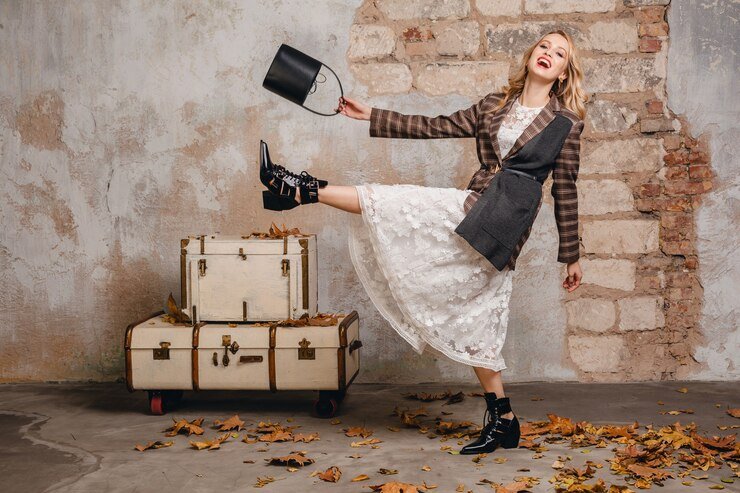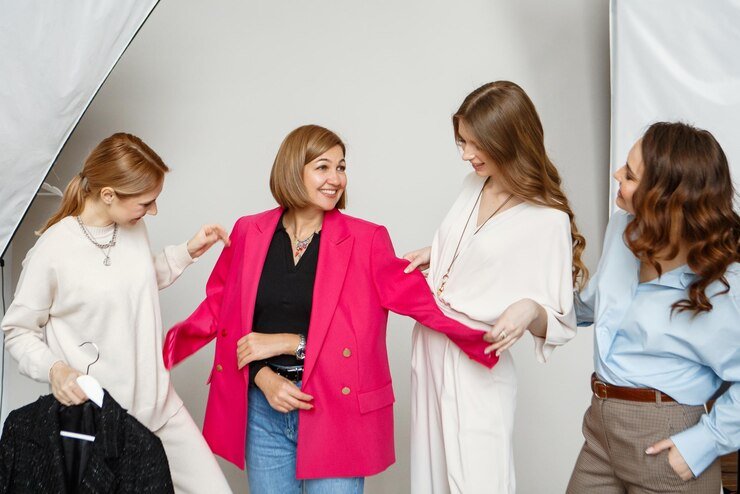
Introduction to the 1920s fashion era
The 1920’s Fashion, often referred to as the Roaring Twenties, was a decade of transformation. It marked a departure from strict Victorian norms and embraced bold creativity in fashion. The styles that emerged during this vibrant era not only reflected the social changes of the time but also laid the groundwork for many contemporary trends we see today.
As jazz music filled speakeasies and flappers danced with abandon, an exciting new world of fashion took center stage. From elegant evening gowns to daring bobbed hairstyles, every detail spoke volumes about newfound freedom and self-expression. This unique blend of cultural shifts and sartorial innovation continues to inspire designers and trendsetters alike.
Join us on a journey through the captivating realm of 1920s fashion, exploring its lasting impact on modern style while uncovering how this iconic decade shaped our current understanding of clothing, identity, and expression.
The Rise of the Flapper: Key Characteristics and Styles
The 1920s marked a radical shift in women’s fashion, with the emergence of the flapper. This dynamic and rebellious spirit defined an era characterized by liberation and self-expression.
Flappers embraced shorter hemlines, often above the knee, breaking away from Victorian norms. Their dresses featured loose silhouettes that allowed for movement and comfort. Fabrics like silk and chiffon were popular choices, adorned with sequins or beading that caught the light on dance floors.
Accessories played a vital role too. Long strands of pearls, cloche hats perched stylishly atop bobbed haircuts, and fringed shawls completed their looks. The bold use of makeup—think dark lipstick and smoky eyes—further emphasized this daring new identity.
Flappers represented more than just a fashion statement; they symbolized women’s newfound freedom during a transformative time in history. Their style was not only visually striking but also charged with social significance.
Influence on Gender Roles and Social Norms
The 1920s marked a turning point in gender roles and social norms. Women began to challenge traditional expectations, embracing new freedoms that came with the era’s fashion trends. The iconic flapper was at the forefront of this movement.
With bobbed hair and shorter hemlines, women expressed their desire for independence. This rebellion against conventional styles symbolized a broader shift towards liberation.
Men’s fashion also evolved during this time, as tailored suits became more accessible and popular among the working class. The blending of styles blurred the lines between genders.
Fashion reflected changing attitudes toward sexuality and personal expression, creating an environment where individuals could showcase their personalities freely. As society grappled with these shifts, fashion became both a reflection and catalyst of evolving gender dynamics in everyday life.
Impact on Fashion Industry and Consumer Culture
The 1920s marked a seismic shift in the fashion industry. It was an era where luxury met accessibility. Designers began to cater not just to the elite but also to the emerging middle class.
Ready-to-wear clothing gained immense popularity, democratizing style for many. This departure from bespoke tailoring allowed more people to express themselves through fashion.
Consumers were eager for change. The rise of department stores made shopping an experience rather than a chore. Women could browse and buy with newfound freedom.
Fashion magazines flourished during this time, shaping public perception and trends like never before. They informed consumers about new styles while promoting aspirational lifestyles.
This wave of innovation laid the groundwork for modern marketing strategies as well, making brands aware that consumer desire can drive their success in ways previously unimagined.
Revival of 1920s Fashion in Contemporary Trends
The revival of 1920s fashion in contemporary trends is more than a fleeting moment; it’s a cultural movement. Modern designers are drawing inspiration from the bold styles that defined an era marked by liberation and creativity.
Today, we see flapper dresses reimagined with fresh fabrics and cuts. Sequins shimmer on evening wear, channeling the opulence of Gatsby parties. Accessories like cloche hats and long strands of pearls have made notable comebacks as well.
Social media plays a pivotal role in this resurgence. Influencers showcase vintage-inspired outfits that celebrate both nostalgia and modernity. Street style also embraces elements like high-waisted trousers and art-deco patterns, blending past aesthetics with today’s sensibilities.
Fashion weeks often highlight collections paying homage to this iconic decade, proving its lasting appeal across generations. The essence of 1920s fashion continues to captivate designers and consumers alike, breathing new life into timeless elegance.
Key Characteristics of 1920s Fashion
The 1920’s fashion era was a vibrant tapestry of innovation and rebellion. It marked a departure from the restrictive styles of previous decades. Flapper dresses, often knee-length and adorned with fringe or sequins, epitomized this shift.
Fabrics became lighter and more comfortable. Silk, chiffon, and jersey allowed for freedom of movement. The drop-waist silhouette defined women’s clothing, emphasizing an athletic look over curves.
Men’s fashion also took center stage during this time. Tailored suits featuring wide lapels were all the rage. Accessories like bow ties and fedoras completed the dapper image.
Colors exploded in popularity as well. Bold hues replaced muted tones, reflecting the exuberance of the Jazz Age.
Patterns such as Art Deco motifs infused garments with geometric charm. This visual language captured an era that celebrated modernity while breaking away from tradition.
The Influence of Iconic Figures like Coco Chanel and Louise Brooks
Coco Chanel and Louise Brooks were pivotal figures in shaping 1920’s fashion. Chanel revolutionized women’s clothing by introducing a more relaxed silhouette, breaking free from corsets. Her designs emphasized comfort without sacrificing elegance.
Brooks, with her iconic bob hairstyle and flapper style, became a symbol of the decade. She represented the modern woman who embraced freedom and self-expression through fashion. Her bold choices influenced countless women to adopt similar looks.
Both women challenged societal norms of their time. They encouraged individuality over conformity, which resonated deeply during the post-war era. This spirit sparked changes in how society viewed femininity and style.
Their legacy continues to permeate contemporary fashion trends today. Designers frequently draw inspiration from their work while celebrating that timeless sense of rebellion and sophistication they embodied.
How 1920s Fashion Continues to Inspire Contemporary Trends
1920s fashion has left an indelible mark on today’s style landscape. Designers frequently draw inspiration from the bold silhouettes and intricate details of this iconic era.
The loose, flowing lines of flapper dresses can be seen in modern cocktail attire, showcasing a blend of elegance and freedom. Contemporary designers often incorporate fringes, sequins, and beadwork reminiscent of 1920s glamour into their collections.
Accessories play a significant role too. Cloche hats and statement headpieces echo the playful spirit of that time while adding vintage flair to current outfits.
Street style also reflects this influence. High-waisted trousers and tailored blazers channel the sophisticated vibe associated with jazz age icons.
Fashion shows regularly feature nods to 1920s aesthetics, proving its timelessness in contemporary wardrobes. This vibrant decade continues to inspire through creativity and innovation within today’s fashion realm.
Examples of Modern Designs Inspired by the 1920s
Modern designers frequently draw inspiration from the bold aesthetics of 1920’s fashion. One standout example is the resurgence of drop-waist dresses, often seen in contemporary cocktail collections.
Many brands incorporate Art Deco patterns into their fabric designs. These geometric shapes and luxe materials evoke a sense of nostalgia while remaining fresh and stylish.
High-fashion runways have showcased wide-brimmed hats reminiscent of the era’s glamour. Paired with sleek silhouettes, these accessories add a touch of vintage flair to modern ensembles.
Jewelry also reflects this influence. Long strands of pearls and intricate headpieces pay homage to flapper styles, allowing today’s wearers to channel that same spirit without losing their individuality.
Even streetwear has adopted elements from the 1920s. Oversized blazers paired with tailored trousers capture an essence that balances classic sophistication with urban edge.
Reflection on the Social and Political Climate of the 1920s
The 1920s, often called the Roaring Twenties, was a time of stark contrasts. The aftermath of World War I left societies grappling with change. Economic prosperity surged in many nations, igniting consumer culture and individualism.
Prohibition marked this era as well. While alcohol was banned, speakeasies flourished underground. This created an air of rebellion that permeated fashion and social norms.
Women gained more freedom during this period. The suffrage movement culminated in women winning the right to vote in several countries. This newfound independence influenced styles—flapper dresses symbolized liberation from traditional roles.
Meanwhile, racial tensions simmered beneath the surface. The Harlem Renaissance celebrated Black culture but also highlighted deep societal divides. Figures like Langston Hughes emerged amidst these complexities.
Fashion both reflected and responded to these shifting dynamics, making the 1920s a pivotal decade for identity expression through clothing choices.
Conclusion: The Enduring Legacy of
The 1920’s fashion era remains a vibrant chapter in the history of style. Its impact is deeply woven into the fabric of contemporary trends, influencing designers and consumers alike. The boldness of flapper dresses, the elegance of Art Deco patterns, and the liberation from traditional gender roles all resonate today.
As we look at modern runways and street styles, echoes of 1920s designs are unmistakable. The playful spirit that characterized this decade has inspired countless creators to infuse their works with a sense of freedom and innovation. Iconic figures like Coco Chanel paved new paths for women’s fashion while challenging societal norms.
Contemporary fashion continues to draw inspiration from this transformative period. Designers often revisit those key characteristics—streamlined silhouettes, luxurious fabrics, and intricate detailing—as they strive to marry nostalgia with modern sensibilities.
The legacy left by 1920’s fashion extends beyond clothing; it reflects changes in culture and attitudes towards femininity, identity, and expression. In every fringe skirt or cloche hat that reappears on today’s streets lies a story—a reminder that our present is shaped by what came before it.
Through its enduring influence on style choices today, the essence of 1920’s fashion underscores not just an aesthetic but a cultural movement that resonates across generations.
RELATED POSTS
View all


